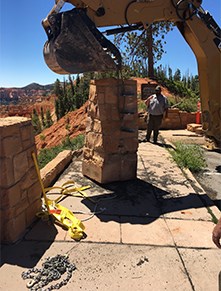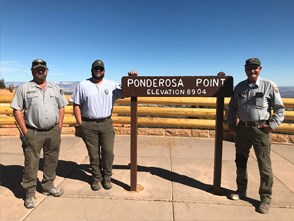Last updated: February 24, 2021
Article
Ponderosa Canyon Viewpoint Repair

All Photos Credit NPS /Jim Hall
For years, a few of the columns at Pondreosa Canyon have been tilting towards the canyon creating an unsafe area for visitors. Most parks have amazing maintenance crews that easily deal with day to day issues, but not all have crews that perform construction work that is typically contracted out to repair issues like this. A little over a year ago the park's Roads and Trails Foreman Floyd Winder, formerly working at Zion National Park, arrived at Bryce and hit the ground running.
Originally, this project was intended with regional involvement, but it was decided it was possible to complete this project in-house. With the arrival of Floyd, the ability to manage crews with excellent skills was now present at the park. A plan was developed to first remove one of tilting columns to investigate how it was installed and then devise a method to stabilizing the columns and replace the sidewalk and wooden barriers.

It turned out that the columns were self-supported structures not connected to anything except the wooden barriers, not typical of construction at other viewpoints within the park. Each column was quite substantial weighing approximately 1,600 lbs. Once it was figured out the column could be lifted out, the corner column was also removed to allow a complete inspection of how the viewpoint was constructed. For the construction nerds out there: it was a slab on grade poured up to the columns, and then the facing stones were set with a thin layer of grout to support them. Remarkably, it’s amazing that none of this failed much earlier. The plan devised was to drill holes into the columns and epoxy in rebar to allow the entire area to be structurally tied together.
As can be seen in the photos below, the sidewalk was removed back to the existing curb. Once all the sidewalk was removed, the positions for the columns were moved in from the rim to allow for additional stability during construction. The area was then prepared by installing formwork for the concrete and then rebar to tie the components together.

The formwork was set up to install a step to install the facing and curb stone on as opposed to the previous construction where they had been set upon a thin layer of grout. Concrete was poured and contraction joints were installed to prevent cracking in the future. As seen in the series of photos at left, the step is an integral part of holding the monolithic structure in place.
The next work to be done was the installation of the facing and curb stones. Typically, facing stones are grouted in place, we decided to glue the stones in place using epoxy and then place grout in between the stones. The reason for this is during the winter, moisture seeps into the grout and then freezes and expands which results in the facing stones “popping” loose. Due to the weight of the stones, they don’t move much, but after cumulative “poppings”, they begin to shift and begin the failure cycle. By using a high strength bonding adhesive, we wanted to test if the cold weather would affect it the same way. The curbing stones were grouted in place above the facing stones.

The last portion of the area to be repaired was the small side wall. Typical construction of these walls is comprised of large slabs of stone; like the other surprises that we found, the wall was constructed of a mix of cinder blocks, some smaller slabs of stones, and stone fascia. The construction team disassembled the wall and then rebuilt the wall using larger slabs.
The resulting product is evidence of a staff that is deeply committed to ensuring that not only safety been restored, but unless you knew what existed before, you would never guess that the viewpoint didn’t always look like it does now. The attention to detail is outstanding and the quality work performed not only showcases the caliber of craftsmen that the park service employs but that, if allowed to perform, the workmanship most often exceeds what outside contractors provide for a fraction of the cost. With the safety concerns resolved, the park has planned additional minor repair work to be the next step to ensure that the visitor has an exceptional viewing experience at this one of many breathtaking viewpoints at Bryce Canyon.

Finally, once the major construction activities were complete, it was time to install the wooden barriers and get the viewpoint reopened. The park sources its logs from fallen trees in the park and from outside local sources. Each log is cut to exact length and then sliced to allow the log to rest on metal “L” channel that protrudes out of the sides of the columns. The logs are then bolted to the metal channel. After installation, the crew comes back to coat the logs with linseed oil, typically 3 to 4 coats. The coating should last a few years before needing a refresh.

Our “main” crew that worked on this project are Duane Sawyer, Kelton Neilson, and Rich Cropper, each very dedicated employees that obviously take pride in the work that they do everyday here at the park. Not all heroes wear an “S” on their chest, some wear an “NPS” on their sleeve.
If you happen to meet one of them out in the park, take a second or a minute, to thank them for their quality work in this park.

Thanks to the park's Chief, Engineer/Project Manager Jim Hall, P.E. for submitting this article. Questions for Jim? Send him an e-mail.
